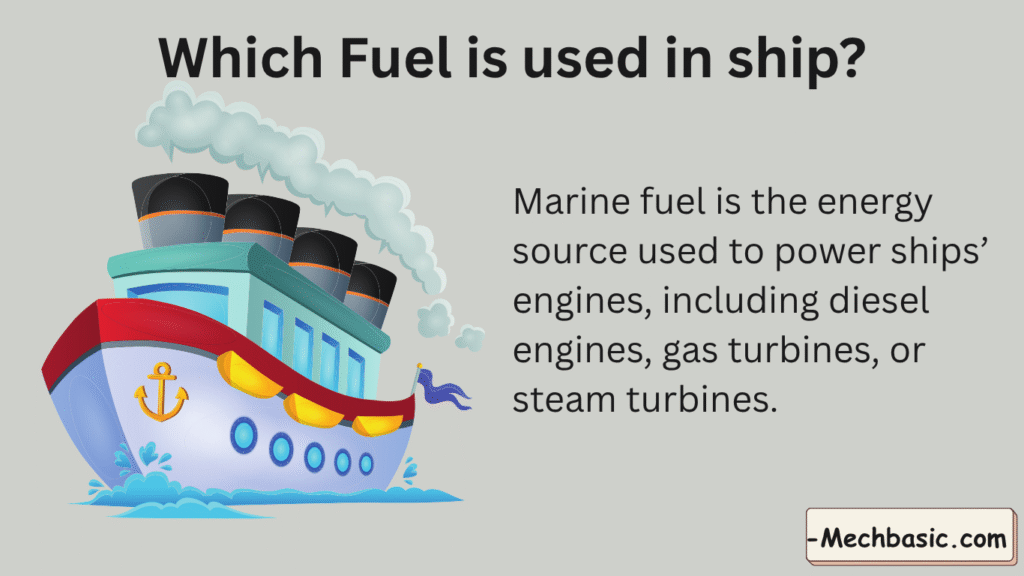Let’s go in detail about the fuels used in ships:

In this article:
1. Definition of Marine Fuel
Marine fuel is the energy source used to power ships’ engines, including diesel engines, gas turbines, or steam turbines.
- Ships require high-energy, dense fuel because they operate continuously for long periods and carry heavy loads.
- The type of fuel depends on the engine type, ship size, and operational requirements.
2. Types of Ship Engines and Their Fuel
A. Diesel Engines
- Most common in modern ships, especially cargo vessels, tankers, and container ships.
- Fuel Types:
- Heavy Fuel Oil (HFO) – also called bunker fuel
- Very viscous, low cost
- Requires heating before use
- Used in large slow-speed marine diesel engines
- Marine Diesel Oil (MDO) / Marine Gas Oil (MGO)
- Lighter and cleaner than HFO
- Used in medium- and high-speed diesel engines
- Heavy Fuel Oil (HFO) – also called bunker fuel
- Characteristics:
- High energy density
- Stable combustion for long voyages
- May require sulfur content regulation (IMO 2020: ≤0.5% sulfur in fuel)
B. Gas Turbine Ships
- Use kerosene-based fuels, similar to Jet A.
- Common in naval ships and fast ferries.
- Advantages: High power-to-weight ratio, fast acceleration.
C. Steam Turbine Ships (Historical / Some Nuclear Ships)
- Fuel Type: Heavy fuel oil or coal (historically)
- Some nuclear-powered vessels use nuclear reactors instead of traditional fuel.
D. Alternative / Emerging Marine Fuels
- Liquefied Natural Gas (LNG):
- Cleaner, reduces sulfur oxide (SOx) and nitrogen oxide (NOx) emissions
- Used in modern cruise ships and ferries
- Biofuels / Synthetic fuels:
- Eco-friendly alternative for smaller vessels
- Hydrogen / Ammonia (experimental):
- Zero-carbon future fuel for shipping
3. Key Properties of Marine Fuel
| Property | Importance |
|---|---|
| High Energy Density | Required to move massive ships over long distances |
| Viscosity & Flow Properties | HFO must be heated for pumping and combustion |
| Sulfur Content | Regulated to meet IMO emission standards |
| Storage Stability | Fuel may be stored for weeks/months at sea |
| Combustion Efficiency | Ensures engine reliability and minimal residue build-up |
4. Summary of Ship Fuel Types
| Engine Type | Fuel Used | Notes |
|---|---|---|
| Large Slow-Speed Diesel | Heavy Fuel Oil (HFO) | Cheap, viscous, needs preheating |
| Medium/High-Speed Diesel | Marine Diesel Oil (MDO) / Marine Gas Oil (MGO) | Cleaner, lighter |
| Gas Turbine | Kerosene / Jet fuel | Fast ships, naval vessels |
| Steam Turbine | Heavy Fuel Oil / Coal | Historical or niche applications |
| LNG / Biofuels | Liquefied natural gas, biodiesel | Emerging eco-friendly options |
| Nuclear | Nuclear reactors | Aircraft carriers, submarines |
✅ Key Points
- Modern cargo ships mostly use HFO or MDO depending on engine type and speed.
- LNG and biofuels are increasingly adopted for environmental compliance.
- Naval ships may use gas turbines or nuclear power for high-speed and long-duration operations.
- Proper fuel handling is critical for safety, engine efficiency, and regulatory compliance.
💡 Tip:
- The IMO 2020 regulation limits sulfur content in marine fuels to 0.5%, pushing the industry toward cleaner fuels like LNG and MGO.
Other courses:



